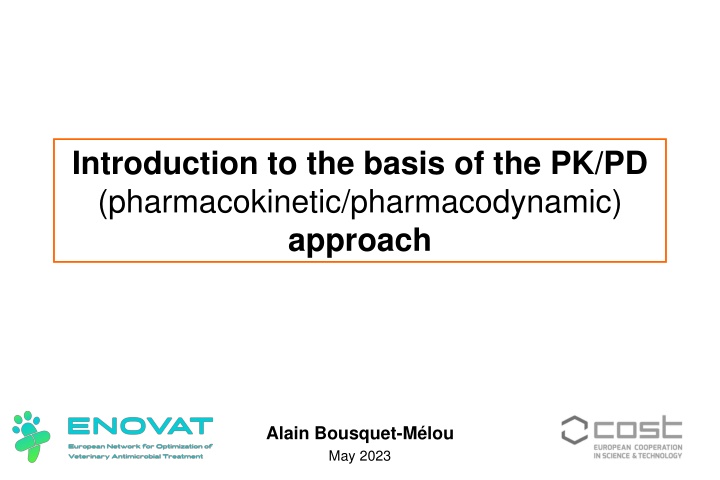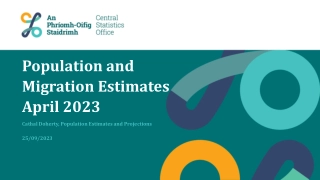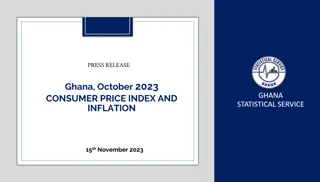
PK/PD Approach in Pharmacology
Explore the fundamental concepts of pharmacokinetics and pharmacodynamics, focusing on dose-exposure-effect relationships, dose-response relationships, and the therapeutic window. Learn how these principles help in determining the optimal dosage and efficacy of drugs.
Download Presentation

Please find below an Image/Link to download the presentation.
The content on the website is provided AS IS for your information and personal use only. It may not be sold, licensed, or shared on other websites without obtaining consent from the author. If you encounter any issues during the download, it is possible that the publisher has removed the file from their server.
You are allowed to download the files provided on this website for personal or commercial use, subject to the condition that they are used lawfully. All files are the property of their respective owners.
The content on the website is provided AS IS for your information and personal use only. It may not be sold, licensed, or shared on other websites without obtaining consent from the author.
E N D
Presentation Transcript
Introduction to the basis of the PK/PD (pharmacokinetic/pharmacodynamic) approach Alain Bousquet-M lou May 2023
Pharmacology Pharmacokinetics Pharmacodynamics Action Action of the drug on the body of the body on the drug
The steps leading to an effect Dose of active ingredient administered Bacteria Insects Pests Therapeutic response ABSORPTION Interactions Pharmacological Targets Concentrations Blood/plasma Concentrations Biophase DISTRIBUTION ELIMINATION Therapeutic response Cellular action PHARMACOKINETICS PHARMACODYNAMICS
The steps leading to an effect Dose of active ingredient administered Bacteria Insects Pests Therapeutic response ABSORPTION Interactions Pharmacological Targets Concentrations Blood/plasma Concentrations Biophase DISTRIBUTION ELIMINATION Therapeutic response Cellular action PHARMACOKINETICS PHARMACODYNAMICS
Pharmacokinetics / Pharmacodynamics Quantitative aspects At the pharmacodynamic level To link the intensity/magnitude of the effect with the concentration of the active compound : establishment of a concentration-effect relationship Objective: to determine the concentration range (exposure) associated with a given effect At the pharmacokinetic level To link the amount of active compound administered/ingested with blood and tissue concentrations : establishment of a dose-concentration relationship Objective: to determine the external dose associated with a given internal exposure (blood/circulating concentrations) Establishment of the Dose-response relationship
Dose-exposure-effect relationships Dose Therapeutic response of active ingredient ABSORPTION Biophase ? Concentrations Plasma Concentrations ELIMINATION DISTRIBUTION PHARMACOKINETICS PHARMACODYNAMICS
PHARMACODYNAMICS Pour simuler diff rents sch mas posologiques, seules les cases soulign es doivent tre modifi es 25 20 0 10 20 14.4 14.4 300 10 20 14.4 14.4 15 Concentration (mg/L) 10 5 0 0 24 48 72 96 120 144 168 192 216 240 264 288 312 336 Temps (h) Concentrations Effects
PHARMACODYNAMICS Pour simuler diff rents sch mas posologiques, seules les cases soulign es doivent tre modifi es 25 20 0 10 20 14.4 14.4 300 10 20 14.4 14.4 15 Concentration (mg/L) Minimal Threshold 10 Associated with maximal probability of therapeutic effect 5 0 0 24 48 72 96 120 144 168 192 216 240 264 288 312 336 Temps (h) Concentrations Effects
PHARMACODYNAMICS Pour simuler diff rents sch mas posologiques, seules les cases soulign es doivent tre modifi es 25 Associated with minimal probability of adverse effect Maximal Threshold 20 0 10 20 14.4 14.4 300 10 20 14.4 14.4 15 Concentration (mg/L) Minimal Threshold 10 Associated with maximal probability of therapeutic effect 5 0 0 24 48 72 96 120 144 168 192 216 240 264 288 312 336 Temps (h) Concentrations Effects
PHARMACODYNAMICS Often absent because well tolerated Pour simuler diff rents sch mas posologiques, seules les cases soulign es doivent tre modifi es 25 Associated with minimal probability of adverse effect 20 0 10 20 14.4 14.4 300 10 20 14.4 14.4 THERAPEUTIC WINDOW FOR ANTIBIOTICS 15 Concentration (mg/L) 10 related to the bacterial susceptibility / linked to the MIC Associated with maximal probability of therapeutic effect 5 0 0 24 48 72 96 120 144 168 192 216 240 264 288 312 336 Temps (h) Concentrations Effects
PHARMACOKINETICS PHARMACODYNAMICS Pour simuler diff rents sch mas posologiques, seules les cases soulign es doivent tre modifi es 25 20 0 10 20 14.4 14.4 300 10 20 14.4 14.4 THERAPEUTIC WINDOW 15 Concentration (mg/L) 10 5 0 0 24 48 72 96 120 144 168 192 216 240 264 288 312 336 Temps (h) Dosage Concentrations Effects
PHARMACOKINETICS PHARMACODYNAMICS Pour simuler diff rents sch mas posologiques, seules les cases soulign es doivent tre modifi es 25 20 0 10 20 14.4 14.4 300 10 20 14.4 14.4 THERAPEUTIC WINDOW 15 Concentration (mg/L) 10 Dosage 1 The same dose Every 24h I.V. 5 0 0 24 48 72 96 120 144 168 192 216 240 264 288 312 336 Temps (h) Dosage Concentrations Effects
PHARMACOKINETICS PHARMACODYNAMICS Pour simuler diff rents sch mas posologiques, seules les cases soulign es doivent tre modifi es 25 20 Multiple dosing : 1. Accumulation 2. Plateau due to an equilibrium 3. Fluctuations within the dosing interval 0 10 20 14.4 14.4 300 10 20 14.4 14.4 15 Concentration (mg/L) 10 Dosage 1 The same dose Every 24h I.V. 5 0 0 24 48 72 96 120 144 168 192 216 240 264 288 312 336 Temps (h) Dosage Concentrations Effects
EXPOSURE PARAMETERS : Peak conc., Trough conc., Average conc., Area under the curve Pour simuler diff rents sch mas posologiques, seules les cases soulign es doivent tre modifi es 25 20 0 10 20 14.4 14.4 300 10 20 14.4 14.4 15 Average Concentration (at equilibrium) Concentration (mg/L) 10 ???24 = 24 ????????,24 5 0 0 24 48 72 96 120 144 168 192 216 240 264 288 312 336 Temps (h) Area under the concentration curve = AUC
Pharmacokinetic parameters PK parameters Steps 1 Bioavailability (F%) 1 - Absorption 2 Volume of distribution (Vd), plasma protein binding (fu) 2 - Distribution 3,4 - Clearance (Cl) 3 - Metabolism 4 - Excretion/Elimination 4 - Half-life (t1/2)
The relationship between pharmacokinetics and pharmacodynamics Elimination capacities Entry into the body Dose = X Target exposure Clearance (Cl) Bioavailability (F) Dose = X Target AUC
The relationship between pharmacokinetics and pharmacodynamics Clearance (Cl) Bioavailability (F) Dose = X Target AUC ???24 = 24 ????????,24 ?????? ???24 = 24 ??????? ???? 24 = ????????? ??????????????? ???????
Basis of the PK/PD (pharmacokinetic / pharmacodynamic) approach in antimicrobial therapy Alain Bousquet-M lou May 2023
Antibiotic doage regimen : what objectives? 1. Maximum efficacy against pathogenic bacteria 2. Minimal emergence and selection of bacterial resistance For target pathogens: efficacy/animal health issues For non-target bacteria: human/environmental health issues
The objectives of a dosage regimen for a veterinary antibiotic Public health issues Animal health issues To achieve a cure without adverse effects To avoid the selection and amplification of bacterial resistances Note: there can be a potential conflict between the two objectives
How to determine a dosage regimen ? by establishing the relationship between doses and effects 1. Animal infection models 2. Clinical trials 3. PK/PD approach
PK/PD approach = identifying and describing steps leading to an effect Administered dose of active ingredient Therapeutic effect ABSORPTION Plasma Biophase/tissular concentrations concentrations ELIMINATION DISTRIBUTION PHARMACOKINETICS PHARMACODYNAMICS
PK/PD approach for antibiotics = identifying the diverse effects Active ingredient administered Plasma concentrations Efficacy Pathogenic bacteria Biophase = Infectious site Resistance selection Elimination PHARMACODYNAMICS PHARMACOKINETICS
PK/PD approach for antibiotics = identifying the diverse effects Resistance selection Zoonotic bacteria Active ingredient administered Biophase Digestive tract (and other commensal flora) Resistance selection Commensal bacteria Break of the barrier against colonization Plasma concentrations Efficacy Pathogenic bacteria Biophase = Infectious site Resistance selection Elimination PHARMACODYNAMICS PHARMACOKINETICS
PK/PD approach for antibiotics What information is needed/available ? Dose of active ingredient administered Therapeutic effect in vitro PD MIC Rates of bacterial killing in vivo PK PK data PK/PD efficacy indices ABSORPTION Infectious site concentrations Plasma concentrations ELIMINATION DISTRIBUTION PHARMACOKINETICS PHARMACODYNAMICS
Pharmacodynamic assessment for the PK/PD approach in antimicrobial therapy Aude Ferran May 2023











